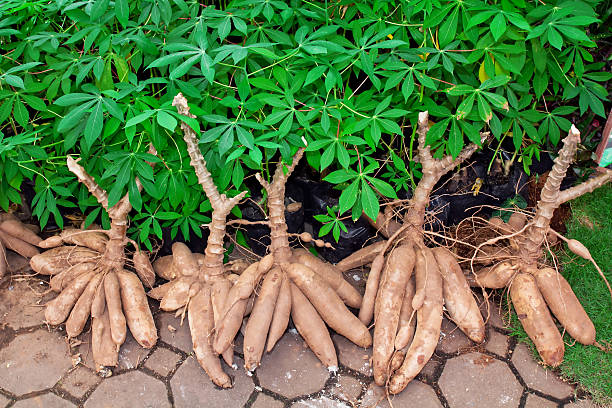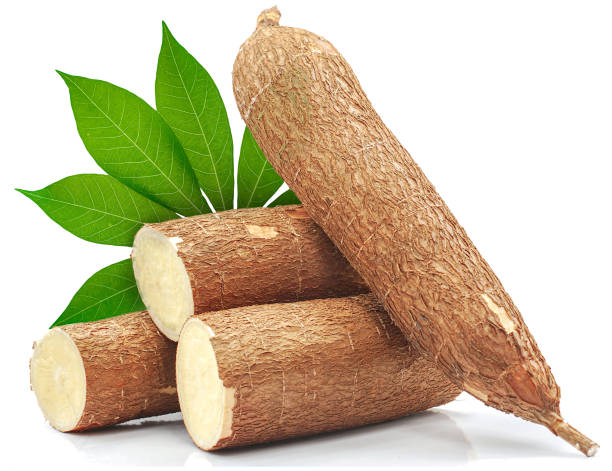

Manihot esculenta Crantz
|
It is commonly known as Cassava. It belongs to the family Euphorbiaceae. Its tuber and tender leaves are consumed in the form of vegetable. Oleic acid, Oxalic acid, Gallic acid, Glutamic acid, Kaempferol, Lauric acid are some of its bioactive compounds. Leaf extract of cassava inhibited proinflammatory markers such as IL-6, TNF-α , MCP-1, PGE-2, NO in stimulated macrophages in dose dependent manner. Moreover, leaf flavonoid extract gel of cassava worked as anti-inflammatory agent and reduced expresions of TNF-α in periodontitis rat models. Mode of Consumption : Fried and cooked |
| Plant Details | Agro-climatic Zone | Vernacular Names | Pictures |
| Scientific Name: Manihot esculenta Crantz Family: Euphorbiaceae Juss. Class: Magnoliopsida Order: Malpighiales Genus: Manihot Mill. Fruiting Season: November-March Parts: Tuber, Tender leaves |
|
Andhra Pradesh : Karrapendalamu Assam : Ruipharkong Karnataka : Kanagala, Mara genasu, Baragaalada gedde Kerala : Kollikkilannu, Maraccini, Marakkilannu Maharashtra : Prochugaali chine, Pavde-pharin Manipur : Umangra Mizoram : Pangbal Nagaland : Seirophei Odisha : Kaato konda Tamil Nadu : Maravallikkilanku, Allvalli kizhangu |
 Harvested roots  Roots |
| Compound/Extract | Activity | Mode of Action | Marker/References |
| Leaf flavonoid gel | Anti-inflammatory | Cassava leaf flavonoid gel worked as anti-inflammatory agent and reduced TNF-α expressions in periodontitis rat models. | TNF-α[1] |
| Leaf extract | Antioxidant, Immunomodulatory | Cassava leaf extract inhibited proinflammatory markers, IL-6, TNF-α , MCP-1, PGE-2, NO in stimulated macrophages in dose dependent manner. | IL-6, TNF-α , MCP-1, PGE-2, and NO[2] |
| Leaf extract | Hepatoprotective | Treatment with Cassava leaf extracts containing flavonoids significantly ameliorated necrosis, cytoplasmic vacuolization and injury in CCl4-induced mice. | [3] |
| Crude extract | Anticancer | Crude extract inhibited the cell growth in ovarian and cervical cancer cell lines. | [4] |
| Major Class | Metabolites (Content of bioactives: mg/100g Fresh Weight) |
| Amino Acid | Alanine: , Arginine: , Aspartic acid: , Cystine: , Glutamic acid: , Glycine: , Histidine: , Isoleucine: , Leucine: , Lysine: , Methionine: , Phenylalanine: , Serine: , Threonine: , Tryptophan: , Tyrosine: , Valine: [5] |
| Carboxylic Acid | Gallic acid: , Hydroxybenzoic acid: , Oxalic acid: , Syringic acid: [2] |
| Carotenoid | Lutein: , β-Carotene: [5] |
| Fatty acid | Lauric acid: , Linoleic acid: , Linolenic acid: , Oleic acid: , Palmitic acid: , Stearic acid: [5] |
| Flavonoid | Apigenin: , Kaempferol: , Rutin: [2] |
| Nitriles | Linamarin: [4] |
| Vitamin | Ascorbic acid (Leaf/Root): , Dehyroascorbic acid: , Niacin (Leaf/Root): , Riboflavin (Leaf/Root): , Thiamin (Leaf/Root): [5] |
| Effect | Observation | DOI |
| Disease | Formulation | Reference | Author | TKDL |
| Information from Wealth of India | Reference |
|
CSIR(1962).The Wealth of India, Raw materials,Vol.-VI ,P.286-297, New Delhi, India |
| 4.2, 4.2.1, 4.2.1.1, 4.2.1.2, 4.2.1.3, 4.2.2, 4.2.2.1, 4.2.2.8 |
|
| CSIR-North East Institute of Science and Technology, Jorhat-6, Assam, India
CSIR-Institute of Himalayan Bioresource Technology, Palampur-61,Himachal Pradesh, India |